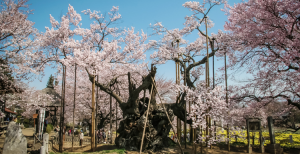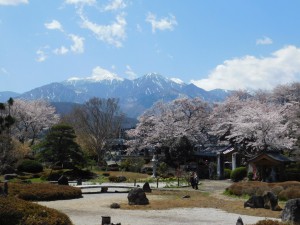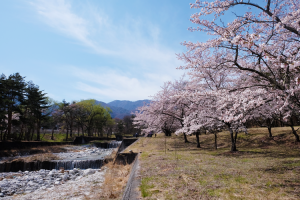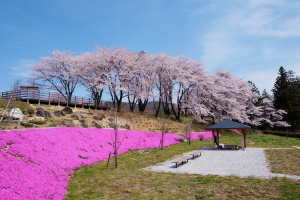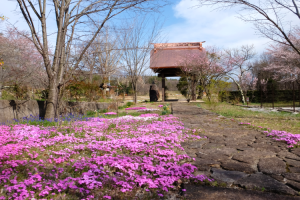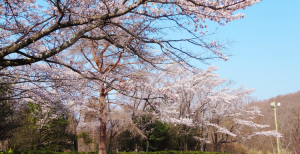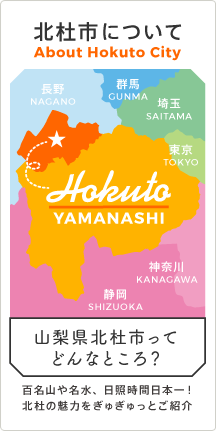北杜のおすすめ観光コース
4月上旬~中旬の桜おすすめコース

1.わに塚の桜
歴史ある塚の中心に咲く樹齢約320年の一本桜
韮崎市段丘の中央、こんもりと盛り上がった塚の中心にある一本桜。樹齢約320年、幹周り3.6m、樹高17mのエドヒガンザクラ。
この塚は日本武尊の王子「武田王」のお墓とも言われることから「王仁塚」とする説や、塚の形が鰐口に似ていることから「鰐塚」とする説など諸説があります。
残雪の山々を背景に咲き誇る姿は、訪れる人々を魅了し、さらに見頃の時期にはライトアップされ幻想的な夜桜を満喫することができます。

車で11.5km 19分
2.山高神代桜
日本三大桜にして日本初の天然記念物指定
山高神代桜は武川町の実相寺境内にそびえる、福島県の三春滝桜・岐阜県の淡墨桜と並ぶ日本三大桜の一つです。
推定樹齢1,800年とも2,000年とも言われるエドヒガンザクラ、樹高10.3m、根元・幹周り11.8mもあり、日本で最古・最大級の巨木として、大正時代に国指定天然記念物第1号となりました。
桜と同じ頃におよそ8万本のラッパ水仙も咲き、足元の黄色と頭上の薄紅色のコントラストがとてもきれいです。
付近の桜スポット:眞原桜並木(車で約5分)

車で3.0km 10分
3.萬休院の桜
3代目舞鶴松と舞鶴庭園が春色に染まる春
萬休院は昭和9年に国の天然記念物に指定された樹齢450年の赤松がありましたが、松くい虫の被害で枯れてしまいました。現在では樹齢100年の3代目舞鶴松が植樹されています。
春シーズンは舞鶴松と綺麗に手入れされた舞鶴庭園を囲む桜と南アルプスの山々の姿はとても趣があり、日本文化の風情を感じることができる桜スポットです。
付近の観光スポット:台ケ原宿(車で約10分)

車で7.7km 14分
4.神宮川の桜並木
名水の産地「白州」の由来となった神宮川
神宮川では、甲斐駒ヶ岳から柔らかい花崗岩が流される間に丸くなり、良質な白玉石が出来あがります。その美しい白玉石は毎年地元の方々により拾い集められ、東京の明治神宮に奉納され、本殿前に使われています。そんな神宮川の透き通る流水と輝く白砂、美しい桜色に咲き匂う桜並木。神宮川の桜並木ではのんびりピクニックやお花見を楽しめる地元に愛されるお花見スポットです。
付近の観光スポット: シャトレーゼ白州工場(車で約5分) / サントリー白州蒸留所(車で約5分) / 道の駅はくしゅう(車で約3分)

車で3.0km 10分
5.ほたる親水公園の桜
台ヶ原宿に春の訪れを知らせる公園
白州・台ケ原の裏手にある、ほたる親水公園は地元の有志の方が蛍が舞っていたかつての宿場町の光景を取り戻そうと、2014年に整備された公園です。
公園内にはおよそ20本ほどの背の高いソメイヨシノが咲くほか、北杜市内では数少ない芝桜も鮮やかに咲き渡ります。
付近の観光スポット: 台ケ原宿(車で約5分) / 道の駅はくしゅう(車で約8分)

車で6.8km 23分
6.龍岸寺の桜
真田信繁の叔父上である真田信伊が眠る花のお寺
NHK大河ドラマ「真田丸」の主人公、真田信繁の叔父上として最近注目を集めている真田信尹ですが、徳川家臣になってから与えられた知行地がここ山梨県北杜市のあたりでした。
その墓所があるのが北杜市長坂にある「龍岸寺」。木蓮や豆桜、芝桜が美しく咲く龍岸寺は「花のお寺」とも呼ばれ、自然豊かな里山に囲まれた境内は春だけでなく四季を通して様々な花々で荘厳されます。
付近の桜スポット 清春芸術村の桜(車で約13分)

車で8.0km 19分
7.ふるさと公園の桜
甲斐源氏の誉れ高き城址に咲くソメイヨシノ
戦国最強の名将・武田信玄を輩した武田家の祖先であり、甲斐源氏の祖でもある新羅三郎義光。彼が京の都から甲斐に移って初めて居館を構えたところと伝えられる若神子城址に作られたのがこの「ふるさと公園」です。ソメイヨシノが約20本植えられており、高台からは須玉の町並みと甲府盆地を一望できます。空が澄んだ日には富士山を見ることもできます。
桜の散った5月には、藤棚も花を咲かせ、北杜の春を刻んでいきます。また、園内には信玄が軍略上の伝達手段として用いたのろし台が復元されています。

車で3.5km 6分

須玉IC
コースマップ
各コースの場所は「ほくとの桜ガイドマップ」を御覧ください。













